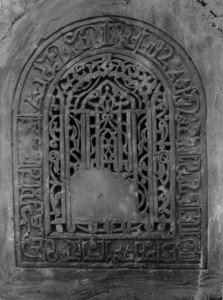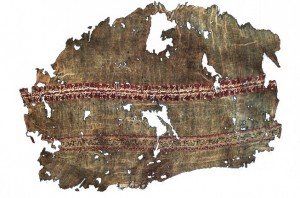The 6th aayat revealed during the restoration and revival of Jami´ Anwar was the discovery of a Fatemi shubbaak: a stucco grille with floral patterns from the original masjid. This grille had long been hidden behind another grille from the Mamluk period, and it was only upon close inspection of the Mamluk grille that the original Fatemi grille was seen, after a period of 698 years. Al-Dai al-Ajal Syedna Aali Qadr Mufaddal Saifuddin TUS mentioned that there was a bird’s nest in front of the Mamluk grille.
The original Fatemi grille revealed during the revival of Anwar
Since the Mamluk grille also had historical value, its removal was contentious, however, in order to maintain the authenticity of the original structure it was removed. Syedna Mohammed Burhanuddin RA directed that the Mamluk grille be preserved, since it had protected the Fatemi one for hundreds of years.
Another grille found in Anwar has inscribed upon it, in mirrored form, the words لله الملك (For Allah is the kingdom) which can also be read as الملك لله (the kingdom is of Allah’s) indicating that Allah’s domain extends over both the spiritual and temporal realms.
The Fatemi grille with the mirrored inscription
A well-known historian had written that this grille is not Fatemi. His claim is disproved on the basis of an existing shawl of Imam Hakim’s AS upon which الملك لله is embroidered in the same script as that found upon the grille, along with a running band of recurring images of two pigeons facing each other.
Imam Hakim’s AS duppatta mubarak
Windows to the Eternal World
Windows can be both open and partially hidden: an open window in known as naafezah while screens and grilles are known as shubbak. A grille allows air and light, essential elements of life, into the room and restricts unwanted things. Syedna al-Dai al-Ajal TUS touched upon the architectural importance of windows and the desire people harbour to acquire residences that have large amounts of glazing that offers breathtaking views. A hotel room with a sea view commands a higher rate than one without one. There are also rooms without any windows at all – cells used to detain people. Bringing the narrative to the technologies of the last century, Syedna al-Dai al-Ajal TUS stated that when the first television was invented it was described as a ‘window onto the whole world’. In the computer age, the use of devices running the Windows operating system allows us to explore the entire world from the comforts of our homes.
Awliyaa’ Allah AS are the divine shubbaks through which we see the divine light of the eternal realm. They ensure that the radiant grace of the hereafter reaches each individual in accordance to their ability and intentions. Shubbaks are an integral feature of Fatemi architecture and it is from such windows that the faithful are blessed. Al-Dai al-Ajal Syedna Abdeali Saifuddin RA would often observe the students of Darse Saifee through a window, and identify the hard-working and studious amongst them. Likewise, each day during the Imtehan of Aljamea-tus-Saifiyah, like Syedna Burhanuddin RA, Syedna Mufaddal Saifuddin TUS graces the ghurfah mubarakah of Iwaan al-Barakaat prior to the viva voce bestowing upon each and every talabat his benevolent glance.
Closing windows
We were also told that some windows allow nefarious and detrimental objects to enter. Thus, just as it is important to open the right windows it is as important to make sure we firmly shut the wrong ones.
In this context, Syedna al-Dai al-Ajal TUS referred to the divine directive to seal all the doors of the houses adjacent to Masjid Nabawi. When the masjid was originally built, several of the Prophet’s companions built their houses adjoining it, each house had a door that opened in to the masjid for direct access. After some years, divine instructions that all doors that led directly to the masjid be sealed save for the door of Rasulullah SA and Amirul Mumineen AS. Though they all immediately complied, some of the companions were greatly upset and expressed their reservations. One even requested that he be permitted to maintain a small window so that he could peep out and see whether or not Rasulullah SA had arrived for namaaz. However, even this was denied. This event, and many other like it, would undeniably lead one to seek justification for burying a person next to someone who did not wish to yield even as much as a keyhole to him.
Syedna TUS spoke of the need for parents to be aware of what their children are learning at school. Education and upbringing are primarily the responsibilities of parents and should not be entirely left to teachers. In the same vein, it is incumbent upon children to obey their parents but once again, like windows, diligence is needed. If parents are deviating from the tenets of faith, then children should never do the same. Syedna TUS spoke of a child who approached him during a recent trip to Mombasa and requested him to direct his mother to pray namaaz. He then related the incident which took place with Abdullah b. ´Amr who was found to be amongst the ranks of the enemies in Siffeen and to whom Imam Husain AS refused to speak to thereafter. Finally, when Imam Husain AS gave him an audience, he claimed that since Rasulullah SA had once told him to obey his father, and he did so by being alongside him in Siffeen. To this, Imam AS questioned him about whether he had come across the Quranic verse:
And if either of them (one’s parents), force you to ascribe a partner to me, of which you have no knowledge, then do not obey them.
Pigeons
Immediately following the narration regarding the authenticity of the Fatemi shubbak, Syedna al-Dai al-Ajal TUS spoke about the merits of pigeons and doves. Pigeons have been created from good elements and because of this they possess the ability to ward off evil spirits and influences. Many Mumineen keep pigeons in their homes, and they are also found in mazaaaraat. Another characteristic of these birds is that they never forget their homes, which was why they were used as messengers in the past, many were even awarded medals for their wartime bravery. Society at large considers pigeons and doves symbols of peace. This is seen in the way they are released prior to international events such as the Olympics. Hawks, on the other hand, are considered belligerent.
In contrast to pigeons and doves are crows. This bird is very much the polar opposite to pigeons in all its traits. One day Imam Jafar al-Sadiq AS admonished a crow that continued to disturb him: perish in your rage! The crow fell to the ground and met its end. When asked about the crow, Imam AS replied that it was Hajaaj b. Yusuf, a bearer of great animosity towards Ahlebayt AS. This difference between pigeons and crows was revealed with reference to two anecdotes of Syedna Mohammed Burhanuddin RA. Once in London, Syedna Burhanuddin RA gazed upon a flock of pigeons and mused over when it would be there turn to ascend to the hereafter. While, in Saifee Mahal, during a bout of illness, a crow perched upon his balcony and cawed noisily to which Syedna Burhanuddin RA commented ‘it is intent on being a nuisance’.
Syedna al-Dai al-Ajal TUS narrated the argument of two pigeons in the masjid of Kufa in which Maulana Ali AS interceded on behalf of the male pigeon who was trying to reassure his female companion that he had not left her for another. ‘Even birds have such worries’ Maula charmingly remarked. Further, in Fatemi literature the soul has been likened to a pigeon while in his lament Syedi Abdeali Mohyiddin QR calls upon pigeons to coo: Mumineen to cry upon Imam Husain AS.
Earlier in the waaz mubarak, Syedna al-Dai al-Ajal TUS stated that Duat Mutlaqeen are the Sheet of Purity that was draped upon Khamsat Athaar AS. That drape is a window through which we can see the glories of Khamsat Athaar AS and Aimmat Tahereen AS. The radiance of Maulatona Fatema’s AS shawl guided a Jew and 80 of his family members to Islam. Todays by glancing at Syedna Mufaddal Saifuddin TUS we are gazing at the divine and eternal, and through him the rays of that realm shine upon our bodies and souls. These rays, are the rays of noh and aweel which are shining upon our hearts. With its warmth and light they free us from the entrapment of this mortal domain.
During her final moments, Maulatona Fatema AS expressed a desire that her ghusl and funeral take place at night, so that no one but a select few be a part of it. After her ruh mubarak ascended to the heavens and night fell, Maulana Ali AS asked Imam Husain AS to call Maulana Abizer RA to aid with the funeral. Maulana Ali AS carried Maulatona Fatema’s AS jism mubarak for burial at night. As they entered the grounds a voice called out to them ‘towards me, towards me!’ When they came to the source of the voice they found that her qabr mubarak had already been divinely excavated. Following the burial, Amirul Mumineen AS entreated to the ground to take care of her; immediately came the reply, ‘I will keep her with compassion; have no fear, head towards your home and sleep without worry’. When Amirul Mumineen AS returned home, Maulatona Zainab AS and Maulatona Umme Kulthum AS questioned Imam Hasan AS and Imam Husain AS, where is our mother? Where has she gone? Then the four of them, two brother and two sisters, came together and grieved.
Today, by the blessings of Maulatona Fatema’s AS mohabbat and the benevolence of the Fatemi Dai, Syedna Mufaddal Saifuddin TUS, regardless of their land of abode, Mumineen lead their lives free of all fear and worry. Year after year, they come together with their fellow brethren in the presence Maula and grieve together, so that they may all remain together in this world and the next.




